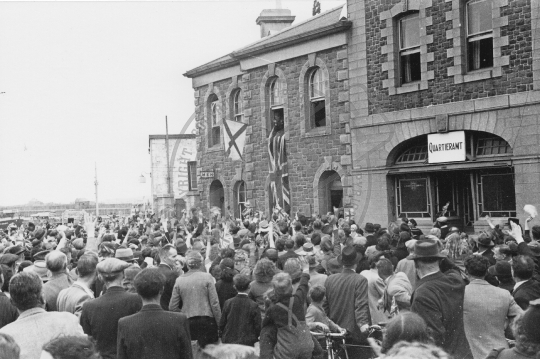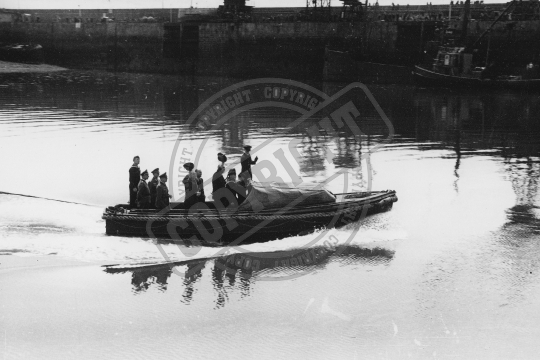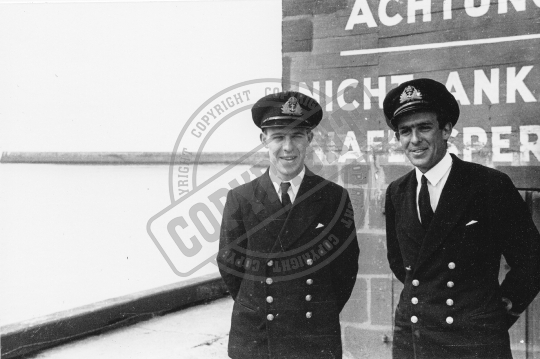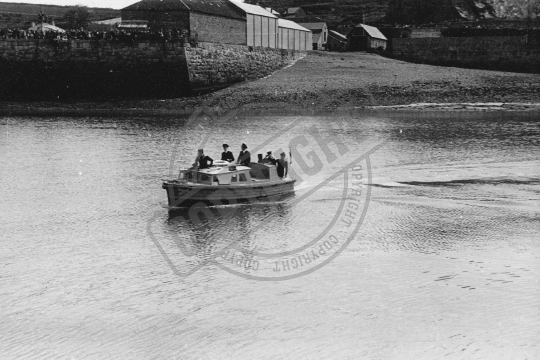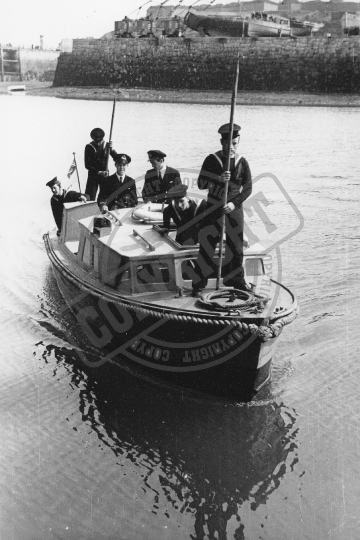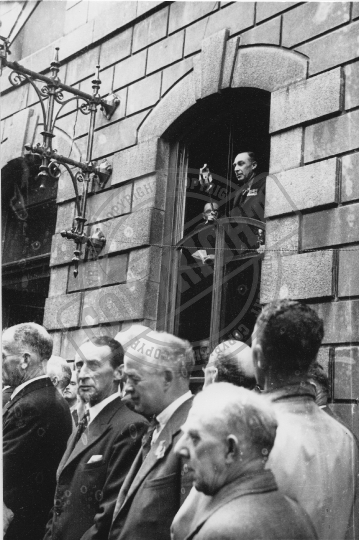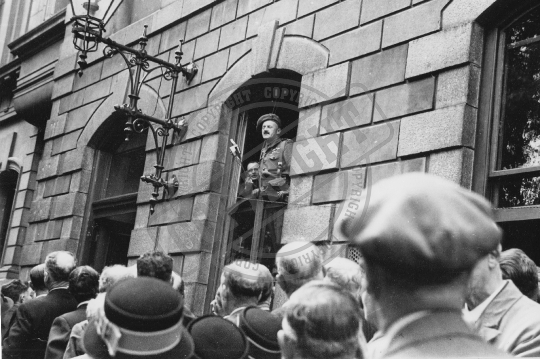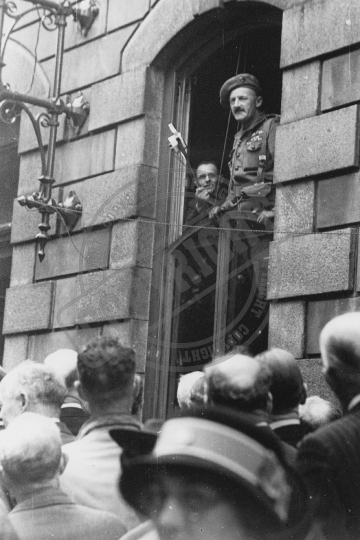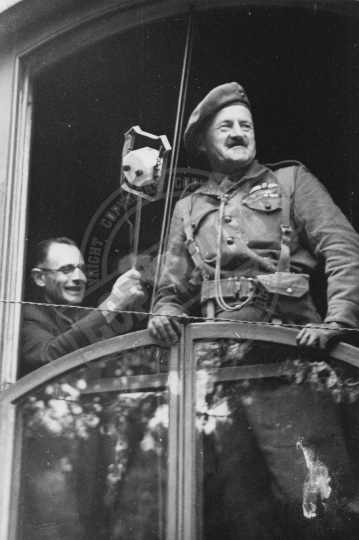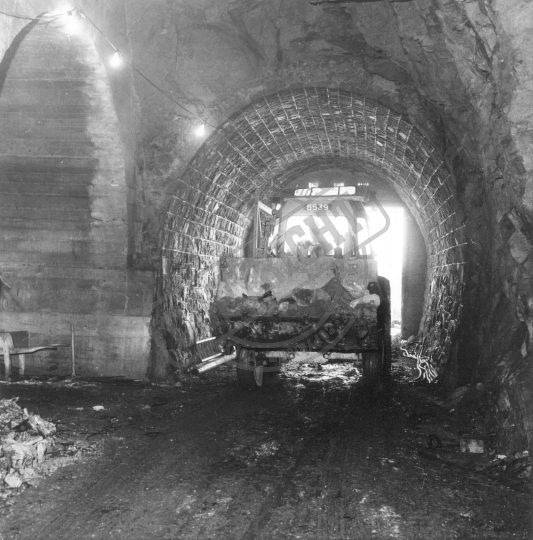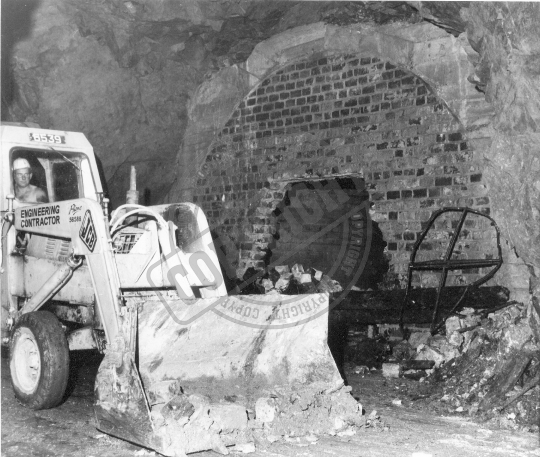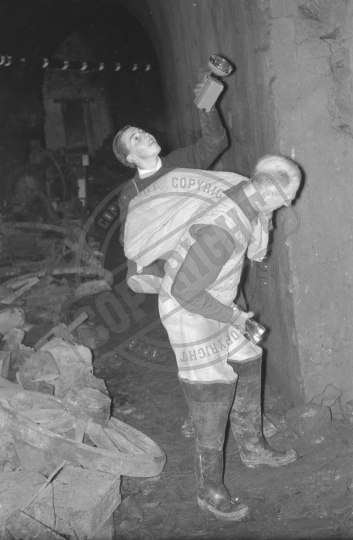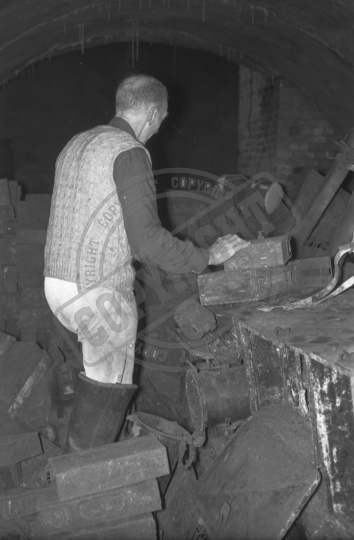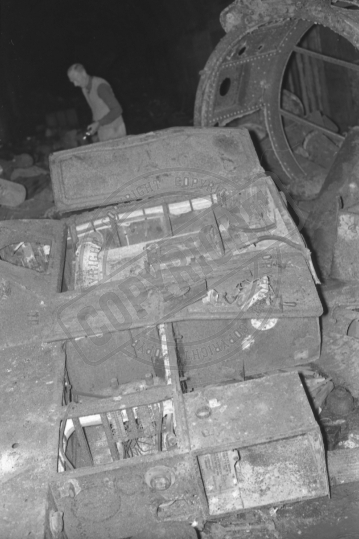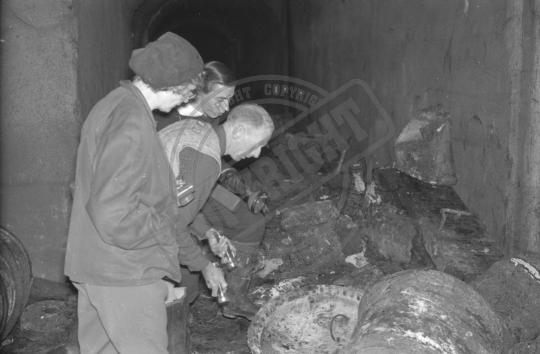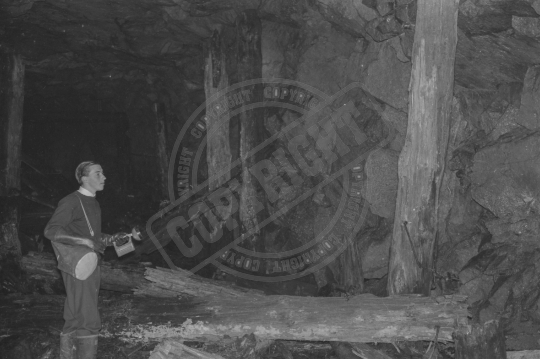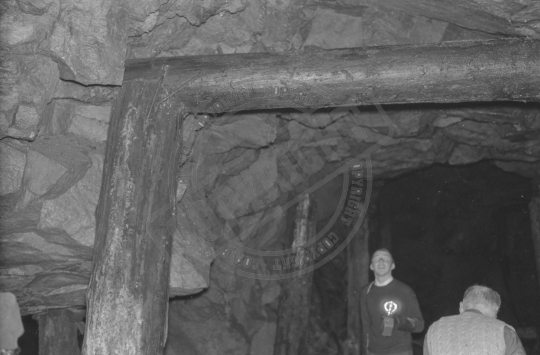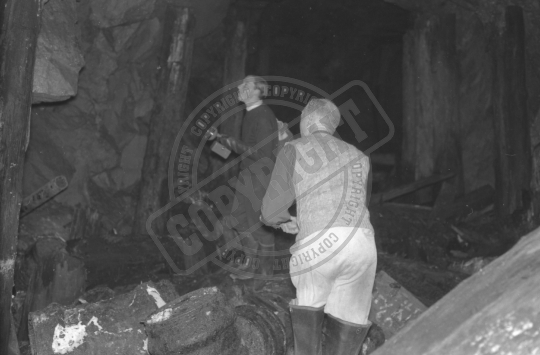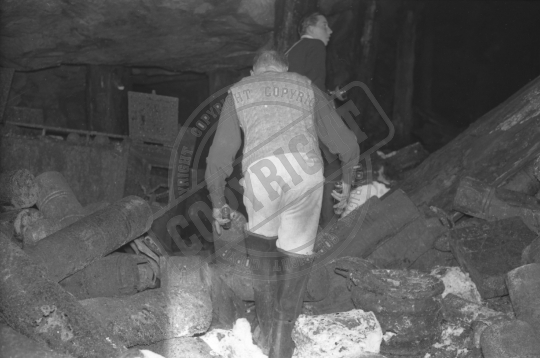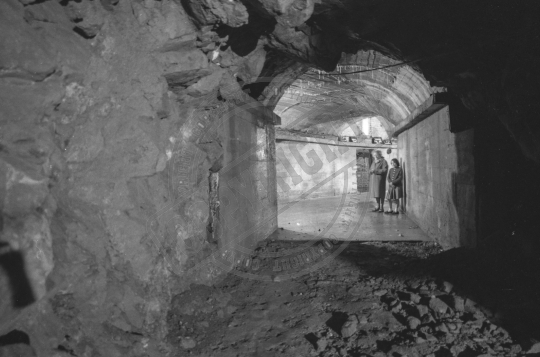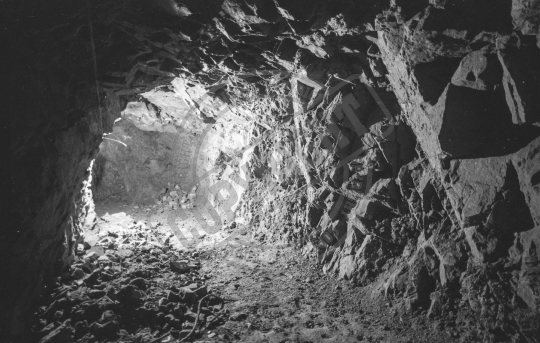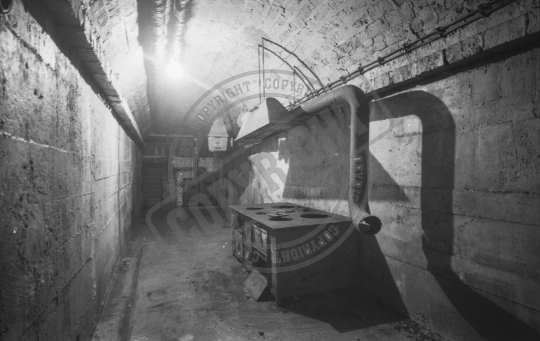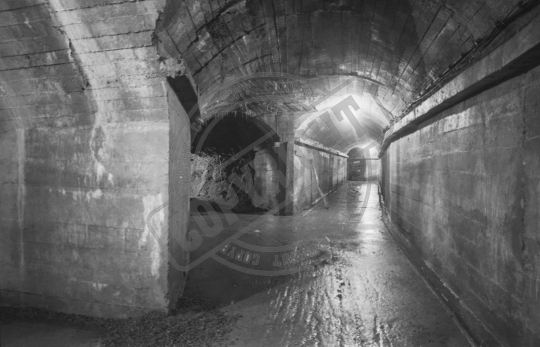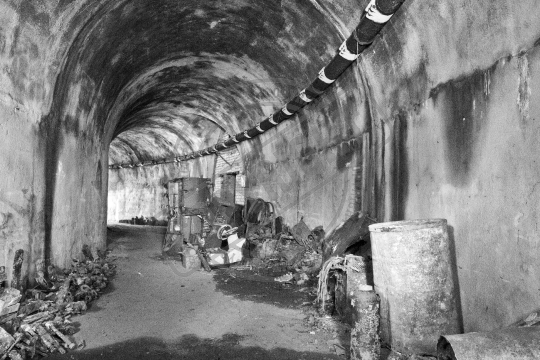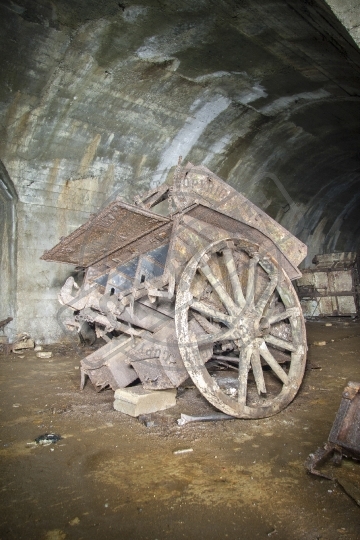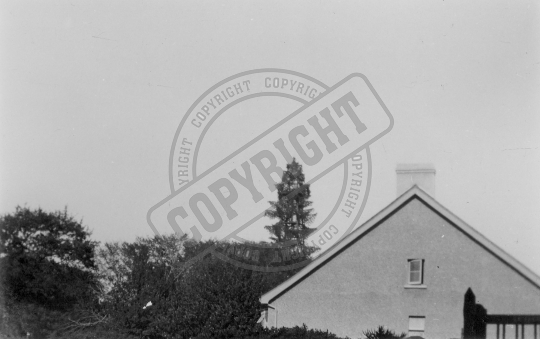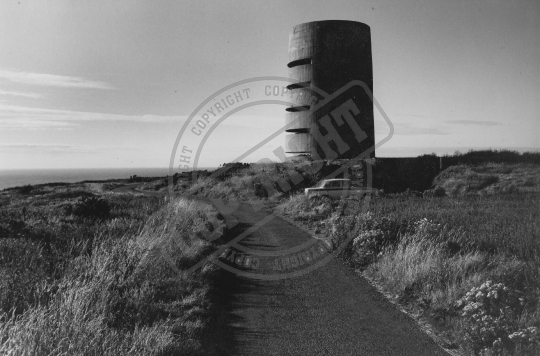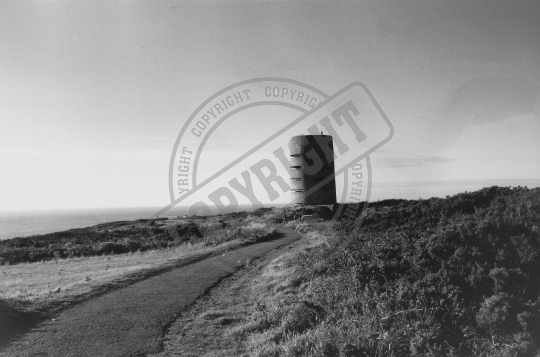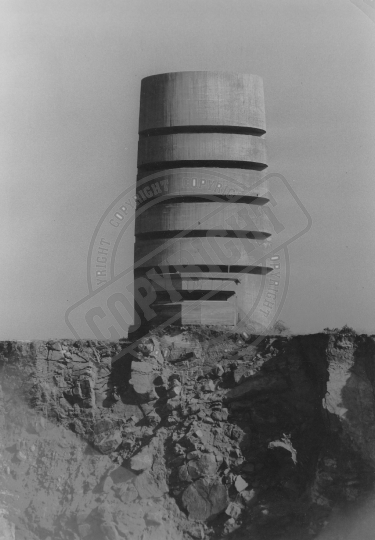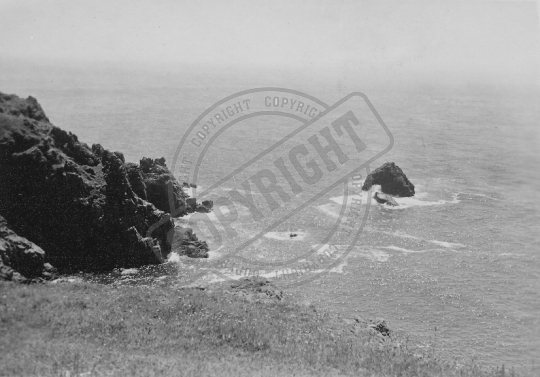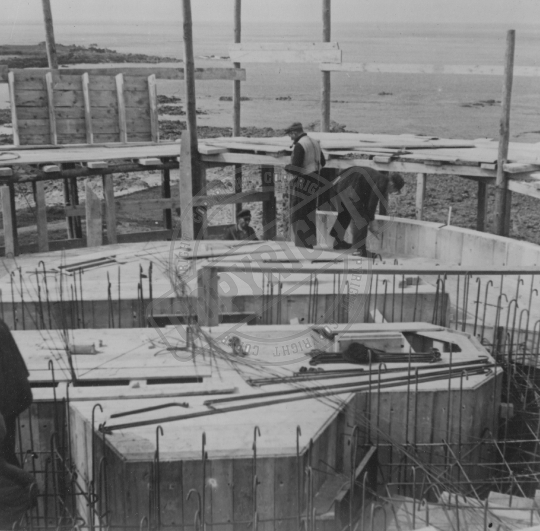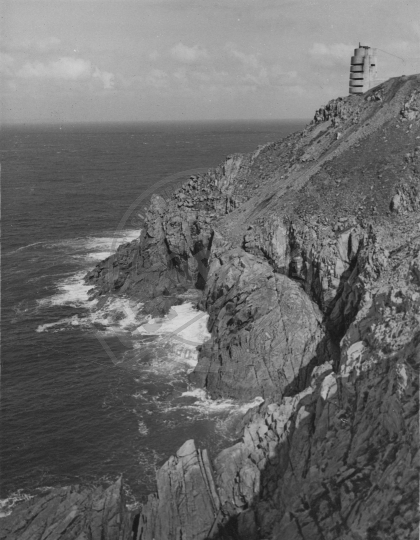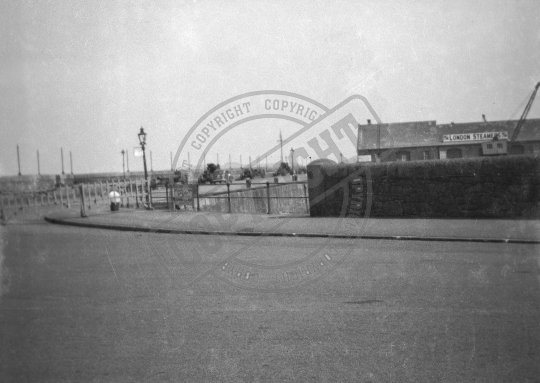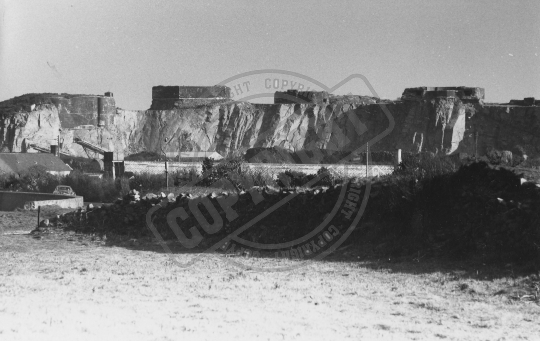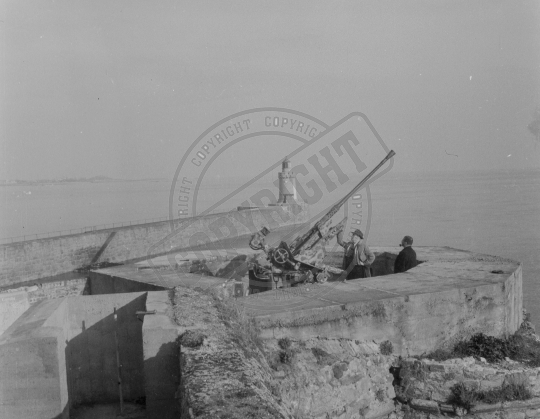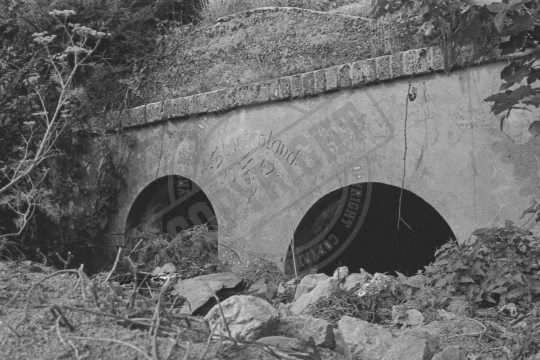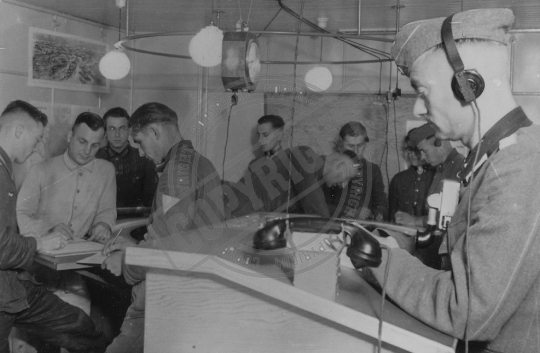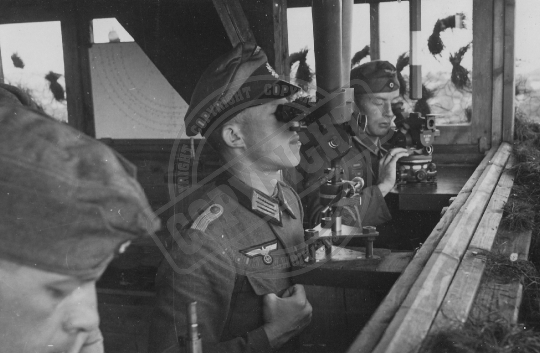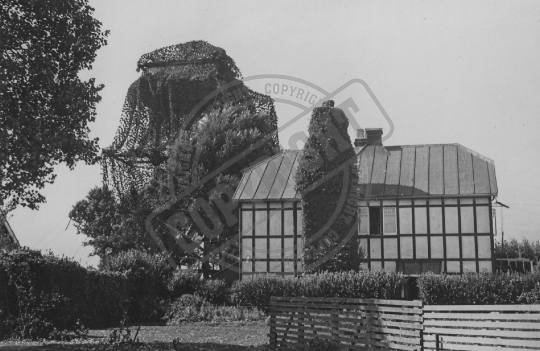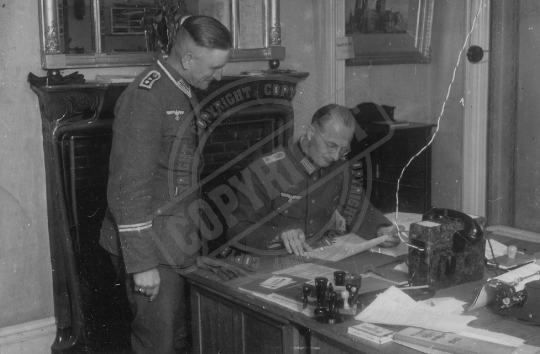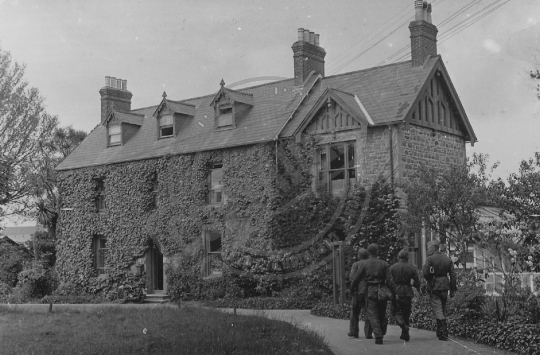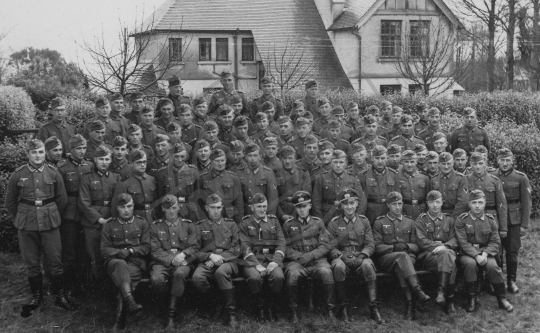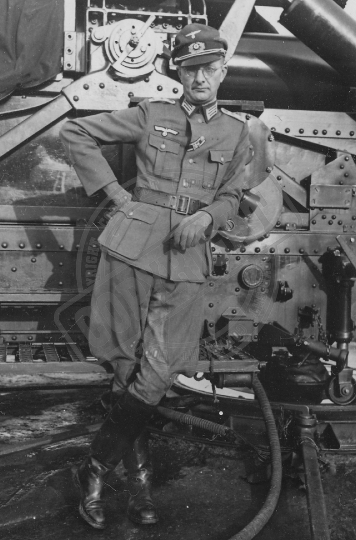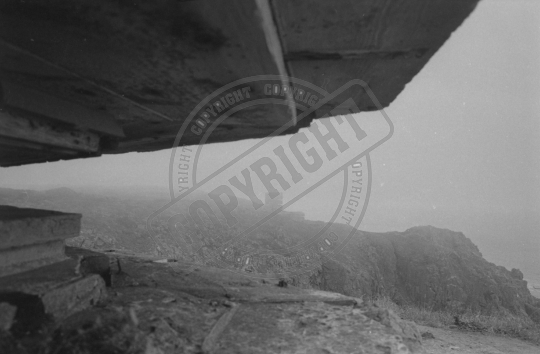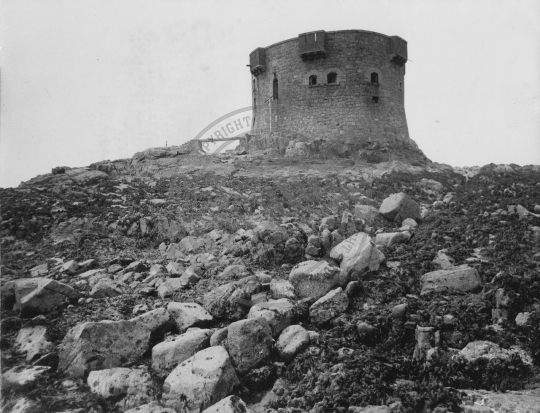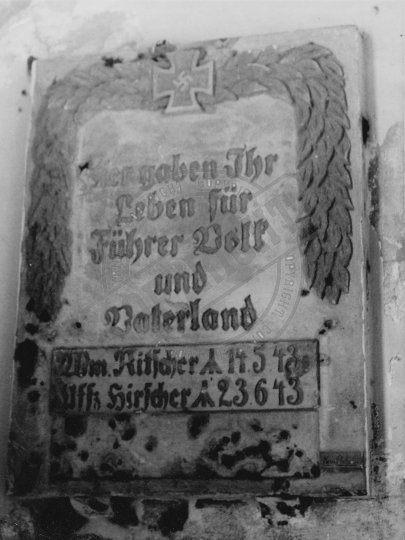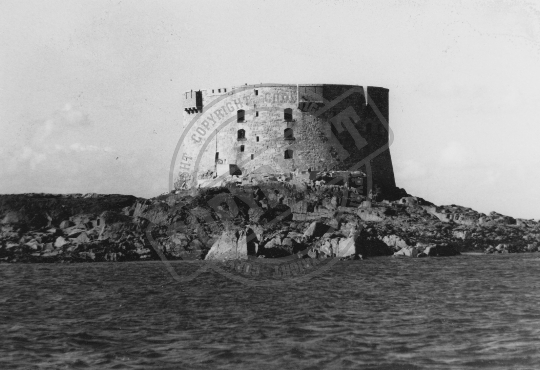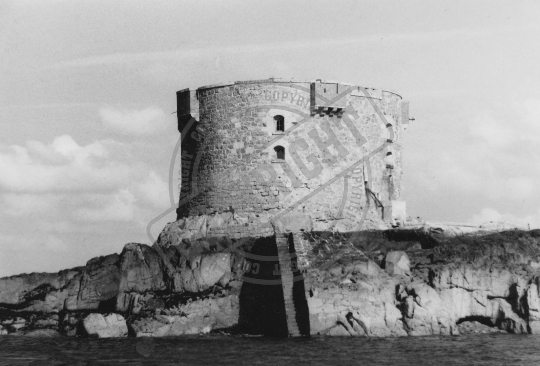Results (211)
CIMM_0028
Crowds gather outside the harbour office in St Helier, Jersey on 9th May 1945 to witness a large Union Flag being draped from the first floor by Surgeon-Lieutenant McDonald with the assistance of Sub-Lieutenant David Milne.
CIMM_0027
Accompanied by Generalmajor Wulf and two staff officers standing at the rear of the Royal Navy pinnace the Bailiff and solicitor general wave their hats as they head out to HMS Beagle where the surrender will be signed.
CIMM_0013
Surgeon-Lieutenant Ronald McDonald, RNVR, and Sub-Lieutenant David Milln, RN, shortly after landing at the end of the Albert Pier, St Helier, Harbour, Jersey, on Wednesday morning 9th May, 1945. The German sign behind them advises Achtung Nicht Ankern Hafenspere (Attention No Anchoring Harbour Boom).
CIMM_0011
The crew of HMS Beagle’s launch make ready to land, and the first Liberators stepped ashore at the end of the Albert Pier, St Helier Harbour, Jersey, on Wednesday morning, 9th May, 1945. The two officers on board were Surgeon-Lieutenant Ronald McDonald, RNVR, and Sub-Lieutenant David Milln, RN.
CIMM_0010
The crew of HMS Beagle’s launch make ready to land, and the first Liberators stepped ashore at the end of the Albert Pier, St Helier Harbour, Jersey, on Wednesday morning, 9th May, 1945. The two officers on board were Surgeon-Lieutenant Ronald McDonald, RNVR, and Sub-Lieutenant David Milln, RN.
CIMM_0009
Addresses to the crowd, from a window of the States Buildings. Many people had gathered in the Royal Square, St Helier, Jersey, for the Hoisting of the Flag Ceremony, on Thursday 10th May, 1945.
CIMM_0007
Lieutenant-Colonel William Robinson, MC, RA, Island commander Jersey, addresses the crowd, from a window of the States Buildings, who had gathered in the Royal Square, St Helier, Jersey, for the Hoisting of the Flag Ceremony, on Thursday 10th May, 1945.
CIMM_0005
Lieutenant-Colonel William Robinson, MC, RA, Island commander Jersey, addresses the crowd, from a window of the States Buildings, who had gathered in the Royal Square, St Helier, Jersey, for the Hoisting of the Flag Ceremony, on Thursday 10th May, 1945.
CIMM_0004
Lieutenant-Colonel William Robinson, MC, RA, Island commander Jersey, addresses the crowd from a window of the States Buildings, who had gathered in the Royal Square, St Helier, Jersey, for the Hoisting of the Flag Ceremony, on Thursday 10th May, 1945.
TPL_00369
The German tunnel complex Ho.8 at La Valette was eventually cleaned out entirely in the early 1960’s prior to its conversion into an aquarium.
TPL_00368
The German tunnel complex Ho.8 at La Valette was eventually cleaned out entirely in the early 1960’s prior to its conversion into an aquarium.
TPL_00352
St Saviour`s tunnel which is featured in many publications as 'The tunnel under the church’ is one of the largest German tunnel complexes in Guernsey. This tunnel was originally constructed as a ration store and in 1944 it was converted into a munitions store. On 9th May 1969 Richard Heaume and John Hayes explored the remains of the tunnel and its contents which had captured the interest of many collectors ever since the scrap men had left in the 1950’s.
TPL_00345
St Saviour`s tunnel which is featured in many publications as 'The tunnel under the church’ is one of the largest German tunnel complexes in Guernsey. This tunnel was originally constructed as a ration store and in 1944 it was converted into a munitions store. On 9th May 1969 Richard Heaume and John Hayes explored the remains of the tunnel and its contents which had captured the interest of many collectors ever since the scrap men had left in the 1950’s.
TPL_00343
St Saviour`s tunnel which is featured in many publications as 'The tunnel under the church’ is one of the largest German tunnel complexes in Guernsey. This tunnel was originally constructed as a ration store and in 1944 it was converted into a munitions store. On 9th May 1969 Richard Heaume and John Hayes explored the remains of the tunnel and its contents which had captured the interest of many collectors ever since the scrap men had left in the 1950’s.
TPL_00341
St Saviour`s tunnel which is featured in many publications as 'The tunnel under the church’ is one of the largest German tunnel complexes in Guernsey. This tunnel was originally constructed as a ration store and in 1944 it was converted into a munitions store. On 9th May 1969 Richard Heaume and John Hayes explored the remains of the tunnel and its contents which had captured the interest of many collectors ever since the scrap men had left in the 1950’s.
TPL_00338
St Saviour`s tunnel which is featured in many publications as 'The tunnel under the church’ is one of the largest German tunnel complexes in Guernsey. This tunnel was originally constructed as a ration store and in 1944 it was converted into a munitions store. On 9th May 1969 Richard Heaume and John Hayes explored the remains of the tunnel and its contents which had captured the interest of many collectors ever since the scrap men had left in the 1950’s.
TPL_00336
St Saviour`s tunnel which is featured in many publications as 'The tunnel under the church’ is one of the largest German tunnel complexes in Guernsey. This tunnel was originally constructed as a ration store and in 1944 it was converted into a munitions store. On 9th May 1969 Richard Heaume and John Hayes explored the remains of the tunnel and its contents which had captured the interest of many collectors ever since the scrap men had left in the 1950’s.
TPL_00334
St Saviour`s tunnel which is featured in many publications as 'The tunnel under the church’ is one of the largest German tunnel complexes in Guernsey. This tunnel was originally constructed as a ration store and in 1944 it was converted into a munitions store. On 9th May 1969 Richard Heaume and John Hayes explored the remains of the tunnel and its contents which had captured the interest of many collectors ever since the scrap men had left in the 1950’s.
TPL_00333
St Saviour`s tunnel which is featured in many publications as 'The tunnel under the church’ is one of the largest German tunnel complexes in Guernsey. This tunnel was originally constructed as a ration store and in 1944 it was converted into a munitions store. On 9th May 1969 Richard Heaume and John Hayes explored the remains of the tunnel and its contents which had captured the interest of many collectors ever since the scrap men had left in the 1950’s.
TPL_00332
St Saviour`s tunnel which is featured in many publications as 'The tunnel under the church’ is one of the largest German tunnel complexes in Guernsey. This tunnel was originally constructed as a ration store and in 1944 it was converted into a munitions store. On 9th May 1969 Richard Heaume and John Hayes explored the remains of the tunnel and its contents which had captured the interest of many collectors ever since the scrap men had left in the 1950’s.
TPL_00155
Post war photograph inside the large tunnel complex known as the German Underground Hospital in St Andrews. This section shows the lined to unlined junction of the tunnel.
TPL_00154
Post war photograph inside the large tunnel complex known as the German Underground Hospital in St Andrews showing the unlined section of the tunnel.
TPL_00152
Post war photograph inside the large tunnel complex known as the German Underground Hospital in St Andrews. The stove and heating equipment can be seen.
TPL_00150
Post war photograph inside the large tunnel complex known as the German Underground Hospital in St Andrews.
SP_0012
During the Occupation the German forces excavated numerous tunnels in Guernsey, these were used for various purposes and many still survive today. This tunnel known as 'the tunnel under the church’ has some original equipment remaining. Note the base of the Würzburg radar on the left of the brick entrance.
SP_0011
During the Occupation the German forces excavated numerous tunnels in Guernsey, these were used for various purposes and many still survive today. Here we see one of the only remaining limbers with a wooden wheel almost fully intact.
TPL_00142
Post war photograph of naval direction finding tower MP1 at Chouet which fell into the quarry in 1991.
SP_0020
Typical of many albums, be they tourist or occupying forces, a scenic view of the cliffs and rocks of Guernsey’s south coast. Seen here is L’Angle with Tas de Pois d’Aval (Gull Rock) seen right taken c.1941, prior to the building of the tower MP4 and the German coastal artillery battery of Batterie Dollman. This Photograph is from a small collection of six taken by an unknown German soldier posted to Guernsey in 1941 with 319 Infantry Division.
OA_066
Marinepeilständen und Messtellen (Naval Coastal Artillery Direction and Range-finding Positions). Post–war view of MP 3 at Les Landes, St Ouen, Jersey, covered the sea passage between Jersey and Guernsey. This tower had Gema Seetakt radar apparatus installed that was officially named Funkmessortungsgerät West (Radio Signalling Apparatus or FuMo West).
TPL_00379
The arrival of a 22cm gun battery at the White Rock, St Peter Port ready for transportation to the gun site. The guns could be disassembled into several lighter loads to facilitate movement if heavy tractors were unavailable. Note the anti-landing poles on the granite wall to prevent enemy landings.
TPL_00134
Post war photograph showing several structures of Batterie Steinbruch prior to their removal during the quarry expansion at Les Vardes, St Sampson.
TPL_00125
Sudetenland 1942 is inscribed in the concrete at Batterie Scharnhorst which was home to four 15cm K18 artillery pieces capable of firing a shell 24.8Km. The guns were transferred to Jersey in 1944.
SP_0027
Inside the command post of Batterie Elefant, Bailiffs Cross Road, St Andrew, Guernsey where plotting information is collated then communicated to the gun positions for aiming and firing. This was situated in close proximity to the 'Paper House’ and the observation tower.
SP_0026
Inside the fire control and observation tower of Batterie Elefant, St Andrew, Guernsey. Here we see the gun control and range-taking staff at work. The tower was adjacent to the 'Paper House’. Note the range board in the background and the camouflage draped over the wooden structure.
SP_0025
This distinctive building was known as the 'Paper House’ and was constructed of lightweight materials resembling paper. The building was situated on a vinery at Bailiffs Cross Road, St Andrew, Guernsey which formed part of Batterie Elefant. The Germans built a fire control and observation tower alongside the building which was draped in camouflage. The 'Paper House’ was demolished in 1978.
SP_0024
The battery commander and the battery sergeant-major of Batterie Elefant inside La Jaoniere, Bailiffs Cross Road, St Andrew, Guernsey. Note the field telephone and the assortment of hand stamps on the table.
SP_0023
Four Germans from Batterie Elefant approach the house known as La Jaoniere at Bailiffs Cross, St Andrew, Guernsey. The house was one of many used by members of the artillery battery during the occupation in the vicinity.
SP_0022
Group photograph showing members of artillery Batterie Elefant which was situated at Bailiffs Cross Road, St Andrew, Guernsey. The photo was taken in the grounds of what is now Les Bourgs Hospice and the building in the background is known as Les Marronniers.
SP_0021
Batterie Elefant situated at Bailiffs Cross Road, St Andrew, Guernsey consisted of three 21cm Morser 18 guns with a range of 16.7km. This was a medium howitzer that had the ability to fire at high angles of elevation. The three guns were mounted on open platforms. Here, the battery commander poses for a photograph alongside one of his guns. Note he is wearing the ribbon of the 1914 Iron Cross, 2nd Class in his second buttonhole, which he won in World War 1.
TPL_00112
Post war photograph looking through the observation slit of the command post of Batterie Dollmann, Pleinmont. In the background MP4 a naval direction finding tower can be seen.
TPL_00093
Ornate cast concrete plaque commemorating the death of Uffz. Hirscher who drowned and another soldier Ritscher, cause of death unknown but possibly from aircraft attack. The plaque was removed from Brehon Tower and is now on display at the German Occupation Museum.
TPL_00087
Post war photograph of Brehon Tower which housed two 2cm Flakvierling anti-aircraft guns on the roof, each weapon comprised of four barrels per gun. The tower also housed a 10.5cm K331(f) gun facing north.



